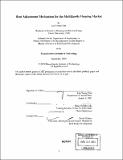| dc.contributor.advisor | Henry Pollakowski. | en_US |
| dc.contributor.author | Yun, Lee-Young, 1976- | en_US |
| dc.contributor.other | Massachusetts Institute of Technology. Dept. of Architecture. | en_US |
| dc.date.accessioned | 2006-03-24T16:24:36Z | |
| dc.date.available | 2006-03-24T16:24:36Z | |
| dc.date.copyright | 2003 | en_US |
| dc.date.issued | 2003 | en_US |
| dc.identifier.uri | http://hdl.handle.net/1721.1/29778 | |
| dc.description | Thesis (S.M.)--Massachusetts Institute of Technology, Dept. of Architecture, 2003. | en_US |
| dc.description | Includes bibliographical references (leaves 45-47). | en_US |
| dc.description.abstract | This study has analyzed the rent adjustment mechanism for the multifamily rental housing in the US during the period 1993-2003 for twenty-four US metropolitan areas. The rent adjustment model employed incorporates the principal argument of search theory that vacancy ultimately determines rent levels. Various time lags on the vacancy rate are tested for each metropolitan area in order to better understand the timing of the effect of the vacancy rate on market rents and to find the best fitting model for each metropolitan area. Two kinds of rents are analyzed : the CPI (Consumer Price Index), 'sitting tenant rent' actually paid by the tenants, and MPF (Market Product Fact), the 'asking rent' for the vacant unit. The results of this study clearly indicate that the rent adjustment models under study explain the MPF rent adjustment mechanism better than the CPI rent adjustment model. Chaning the vacancy lag does not improve the CPI rent adjustment mechanism. The results of this study suggest further studies to explore the behaviors of lessors and lessees to explain why CPI rents behaves as they do. The findings identified through this research provide a helpful basis for advancing an improved theoretical and empirical formulation that highlights the complexities of the rent adjustment process. From a practical point of view, the results can help real estate investment analysts to better model and forecast rent changes in residential real estate market. | en_US |
| dc.description.statementofresponsibility | by Lee-Young Yun. | en_US |
| dc.format.extent | 47, [6] leaves | en_US |
| dc.format.extent | 2371440 bytes | |
| dc.format.extent | 2371248 bytes | |
| dc.format.mimetype | application/pdf | |
| dc.format.mimetype | application/pdf | |
| dc.language.iso | eng | en_US |
| dc.publisher | Massachusetts Institute of Technology | en_US |
| dc.rights | M.I.T. theses are protected by copyright. They may be viewed from this source for any purpose, but reproduction or distribution in any format is prohibited without written permission. See provided URL for inquiries about permission. | en_US |
| dc.rights.uri | http://dspace.mit.edu/handle/1721.1/7582 | |
| dc.subject | Architecture. | en_US |
| dc.title | Rent adjustment mechanism for the multifamily housing market | en_US |
| dc.type | Thesis | en_US |
| dc.description.degree | S.M. | en_US |
| dc.contributor.department | Massachusetts Institute of Technology. Department of Architecture | |
| dc.identifier.oclc | 54756318 | en_US |
